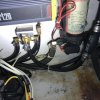As stated in my restoration post, replacing my tank in my 87, what really stood out was that everywhere the rubber strips contacted the tank is where extensive corrosion occurred. The rest of the bare aluminum had a light oxidation on it with no sign of a problem. The early design of my bilge has raised pads that hold the tank about 1-1/4" or so above the bottom of the bilge. These contact areas are where the most pressure and slight movement would occur, rubber strips were placed over these and held moisture against the tank. The sides of the tank had wood wedges screwed to the stringers and bulkheads with rubber strips in between, these areas also caused deep corrosion. Lastly, the top of the tank had three 2x4's with rubber strips between them and the tank screwed to each stringer, again, deep corrosion present. My main concern during replacement was trying to eliminate the rubber product, and the rubbing or movement against the tank surface. On the bottom I attached 3/16" fiberglass pads with 5200 at every contact point on the bottom, then placing expanded PVC between those and the raised pads in the bilge. All side and top contact points had the expanded PVC attached with 5200 so no moisture can get between it and the tank. My thinking is that the expanded pvc will allow slight cushion but movement will not occur against the tank and wear at the epoxy primer. Also, I'm told that rubber accelerates corrosion on aluminum because of carbon content. It will be interesting to see down the road how well it holds up, the epoxy primer and 5200 would have to give up before any moisture can get to the aluminum.
My 226 having twin outboards required it to only have a forward located main tank for weight balance, the rear compartment is empty. I'm considering installing a small fresh water tank in it at some point. I also considered having a fish box retro fitted into that space that could also be used for storage.









